#two-state dissolution
Explore tagged Tumblr posts
Text
not to be a usamericanophobe but i was watching um, actually (a fun low-stakes quiz show i enjoy when my brain is fried) and i cannot fucking believe that none of the contestants knew that yugoslavia is not a currently existing european country. that's genuinely crazy to me like??? have you not checked a map of the world in the past two decades???
#its dissolution was the source of over a decade of territorial conflicts?? was this not a thing that reached the united states of america??#(by its dissolution here i mean the slow reduction of its territory between 92 and 03)#but also it's not like the territorial disputes are even over it's just that yugoslavia hasn't been a part of them in 21 years#you know. because it doesn't EXIST anymore????#like i'm not the most knowledgeable person about the specifics of any of those conflicts. but YUGOSLAVIA??#it's been (had to check the exact date) almost TWENTY-TWO years. that's enough time to hear about it#anyway. at least one of them had the decency to admit this was like important common knowledge they should've had#idk why i got so worked up about this. but the shock was intense#rambles#haterism
1 note
·
View note
Text
I am too tired to cover all the protests against mass deportantion, USAID dissolution, Treasury Invasion, etc., but you can find them all over the country and the world.
This was today, but I'm putting it hear because it gives some scope.
#Democrats#Musk#Mike Johnson#Elon Musk#DOGE#Judy Chu#Gwen Moore#U.S.#protests#Donald Trump#News#Anti-Trump March#Unions#Treasury payments#Lawsuit
1K notes
·
View notes
Note
There is no magic "abolish the state" button, which is why I'm an anarchist, as "when the state has socialismed enough it will just magically poof away in a cloud of smoke" is the leninist position.
That is not the Leninist position, the Leninist position is and always has been that the state cannot disappear until the material conditions for its disappearance are achieved. The withering away of the state, first outlined by Engels, is not a magic process but one that proceeds from the abolition of class and the dissolution of the bourgeoisie.
How are you going to get rid of the bourgeoisie without a state? Are you going to simply ask them nicely to leave you alone? If you are organized and if your organization is suppressing the bourgeoisie as a class, then you have created a state, you have created an authoritarian imposition on the free organization of some section of the people. If you are not doing any of this, then the bourgeoisie who you have left unmolested will invariably come to dominate you once more.
Anarchists have always played word games to get around these simple facts. There are the practical anarchists who will admit to some amount of authority, but always with the caveat that theirs is *just* authority, *necessary* authority, and that is is the *unjust* authority that they condemn. Just authority is not the State, because the State is unjust, and so if they see an authority as just then it cannot be the State. Fair enough, you can call things by whatever names you like, but if you put these ideas in practice you basically end up with Leninism. You want to create dual power? You want to abolish the bourgeois state and replace it with a democratic organ of the working class? Well so did Lenin, and now you know why the Mensheviks accused him of anarchism.
Then there are the quite impractical capital-A Anarchists, who are adamant that anarchy means anarchy and that even voluntary hierarchy and submission to democratic authority is impermissible. Whether pacifistic or militaristic, they are generally unremarkable and ineffective at their goals because they eschew most effective forms of organization as ideologically impure. Even the most advanced anarchists, the CNT in Spain and the Maknovists in Russia, were plagued by economic confusion and disorganization. Their lack of discipline led to their downfall.
If you want to read more, here are some pertinent links:
1K notes
·
View notes
Text
In The Drivers Seat
Summary : Toto drives his daughter’s friend home…it’s so innocent. Rating : 18+ Pairing: Toto Wolff x Reader Word Count : 1,400+ words PART 1 of a 2 PART Trigger Warnings : NSFW, sexual discussion, age gap but not implicitly stated, mild swearing and mature themes. Images : curated from Pintrest Authors Note : Play Diet Pepsi by Addison Rae and you will get the vibe here 😂!! Also, let’s see if you can find the almost direct Fleabag dialogue lift 🫣 Andrew Scott as hot priest lives in my brain RENT FREE!!!

When we drive in your car, I'm your baby
Losing all my innocence in the backseat
Say you love, say you love, say you love me
Losing all my innocence in the backsеat
“I’ll drive you home.”
Four words. He only spoke four words and you could feel the effect they had on you instantaneously. The tight knotting deep down in your stomach. The heat that pricked up on the back of your neck. The dangerous pulsating throb that sparked between your thighs at the sheer thought of being alone with him in such a tight, confined space as his vintage Mercedes. Although younger in years, you weren’t so naïve not to be able to read what was going on. Youth may have been your blessing and curse - you were perhaps too young for him after all - but there was fire there between you that was undeniable. You felt it from the moment your friend - his daughter - first invited you home to her family home that summer two years ago. The lingering stares and intent questioning was unlike how most fathers of friends acted toward you. If it had been anyone else you would have perhaps called them a creep, been weirded out, it may have made your skin crawl. But not with Toto. None of them were anything remotely like Toto Wolff. None of them were as powerful, rich, alluring and down right fuckable as Toto fucking Wolff.
“Thank you, Mr Wolff.” You paused but not without a smile in his direction. Momentarily you visualised the line you knew was about to be crossed the second you walked from the impressive cliff top house overlooking the sea and got into his car, just the pair of you, alone. You considered the fact that if anything happened (confident that it indeed would) would lead to the dissolution of friendship between you and Rosa - if she found out. For the briefest of seconds you contemplated turning his offer down and insist on calling an Uber instead but as you saw the metal of his keys glisten in his hand you found yourself picking up your bag and telling your friend a swift goodbye. Decision decided.
Ever the considerate gentleman, Toto opened the car door and held it for you as you slipped into the seat. His height and your new low down position didn’t escape you. It was perhaps a highly convenient way for him to be able to look down your low cut top and observe your bra - if you had been wearing one. When you glanced up, eyes all big, round and doe-eyed (somewhat hoping to convey the dirty thoughts that were indeed circling around your own head in that moment) it also gave him the opportunity to imagine you on your knees for him. The thought sent another unmistakable flutter in between your legs which you had to push aside as Toto closed the door, crossed in front of the car and slipped into the drivers seat beside you.
The roads leading from his remarkable scenic abode down to the streets of Monaco wouldn’t take long, depending on the state of traffic at such a late hour. As he made small talk you wondered if you were going to have to be the one to make the move you had spent two years fantasising about. You had spent some considerable time thinking about it in the past and in every scenario it was he who crossed the line first so this was unexpected.
“Obviously I know what you do now but, you were a driver right?” “Well, not in Formula One but I did a little bit.” This was it, your gateway. “You must have been good. It’s not hard to imagine you being good, at everything.” It brought out a little shrug, laugh and smile but more importantly it made him glance over to your position next to him. You smiled back at him and hoped he picked up on the way your voice had changed. It was, in your own opinion, slower and sultrier.
“Are you Mr Wolff?” You added hoping he wouldn’t change the conversation. “Are you good at everything?”
“I try to be.” Never tearing your eyes from him as he drove paid off because as soon as he answered he swallowed. Was he nervous? Did your quizzing make him nervous or was it you? Did you make him nervous?
As he reached to change gear your saw his hand flex. How Mr Darcy of him, you thought and it made you smile. “Are you ok, Mr Wolff?” “Don’t call me that.” He spoke through gritted teeth and his jaw flexed the way men’s jaws flex when they’re trying to rid themselves of the dirty ideas that had sprung into their heads. He didn’t mean his words as a reprimand. It was more of a warning. Just as you were about to ask why he looked over at you and added; “don’t call me Mr Wolff like it doesn’t turn you on to call me that.” He read you like a book and you had to hide the smirk that was threatening to dance across your mouth. Rounding a corner, Toto verged the car off into a lay-by so quickly you didn’t even have time to register it. Your breath caught in your throat and your heart hammered against your ribcage so hard you thought it was going to burst out.
Now with the handbrake firmly on and his attention on you - only you - you silently prayed you hadn’t misread the signs. The ache for him to touch you in the most of intimate places deepened from the way he looked at you now you had his whole attention. Tilting your head down to make you look more innocent, through your lashes you awaited whatever he was going to say. Your name poured from him upon a sigh. “Why did you stop, Mr Wolff?” You couldn’t resist calling it one more time to check the waters (as it were). He swore under his breath and shook his head as he tried not to laugh.
“So you have been flirting then?” Confidence dripped from him. “All this time?” You nodded slowly and your name once again flowed out of him. “I’m your friends father. I’m old enough to be YOUR father.”
“And?” You pouted. “I’m attracted to you, you’re attracted to me, what does it matter?” He didn’t answer so you simply continued. “Are you really going to take me home? Drop me off, with this desperate need to be touched and leave me all alone to do it myself?” The confidence you exuded right then could have filled Maddison Square Garden. It was difficult to think if you had ever sounded this self assured with anyone else or if it was simply the effect he had on you. Your hands trailed up your bare thighs as you angled your body toward him and pressed them tightly together. He looked at them, of course, before giving into his desires and allowing his gaze to amble up and to take in how your nipples had hardened against the fabric of your tee. The turning cogs of his inner mind were almost visible - his frontal lobe desperately trying to decide between what was right and wrong and if having sex with his daughters friend was REALLY that bad.
“Do you need some help deciding?” The question was laced thoroughly with sexual anticipation and down right unashamed want. “Let me help you.” The way you easily and effortlessly flung your leg over the centre console and manoeuvred straight into his lap - slotting against his hard body and the steering wheel - was as if you had done this before and had a lot of practice.
His chest was hard as you placed your small hands upon it. His warmth radiating from him and with your hands now upon him you could feel how calm and collected he was. His breathing hardly pitching up at all, his heart beating at a normal rhythm. It surprised you in all honesty but it wasn’t unwelcome. His confidence was so damn sexy after all.
“Does this help?” Asking only inches from his lips, but you figure it may not have been quite enough. So, without any hesitation you lowered yourself a little more so your shorts covered core was pressed against his straining jean covered crotch. “How about this?” Once again he sighed out your name but it wasn’t a sign to stop. No, his hands engulfing around your waist (firmly holding you in place) was a sign it was anything but a sign to stop.
“Toto,” It was the very first time you used his name and he wasted not one single second upon hearing it, his lips were on yours and you knew this was happening. You were getting exactly what you wanted.
#toto wolff#toto wolff imagine#Toto Wolff imagines#toto wolff fanfic#f1 fanfic#f1 imagine#f1 one shot#f1 smut#f1 x reader#f1 fanfiction#toto wolff x reader
610 notes
·
View notes
Text
University of California hiring freeze. FUCK.
I had open applications out to be a staff scientist or research associate at two campuses. And also another university that also has a hiring freeze.
I'm sending out applications already, and have guaranteed stability through to September. After that, it'll be coasting on savings.
I have connections in biotech but it's looking grim. My most hopeful connection is my literal dream job, so I'm waiting to see if that pans out. I'm hoping my bioinformatics and coding experience gives me a bit of a leg up over other people.... But my primary background is still in biology, in genetics. And even the more computational sectors are suffering.
But if it doesn't... It might be leave the country time. Not now, but at the end of 2025 I need to reexamine the state of things. I have weak professional connections in other countries, notably Canada, Germany, and *maybe* Aotearoa. Unfortunately my ancestry doesn't let me leverage citizenship in a place that's any better than the US, especially for trans issues.
I can survive here as a trans person, but with zero job, no safety net? Fuck. Time to seriously consider where two masters degrees and lots of experience can get me for immigration.
Venting to the void, reblogs off, but dear god it's harrowing seeing the dissolution of biological science research in the US.
177 notes
·
View notes
Text
✰NEPTUNE IN ARIES✰
A once in a lifetime astrological event!

©️GeminiMoonMadness
✧・゚:*✧・゚:* ✧・゚: *✧・゚:* ✧・゚: *✧・゚:*
Neptune takes roughly 165 years to transit the whole zodiac and has been happily swimming through his own sign of Pisces since 2011. Neptune will transit Aries from 2025 to 2039, spending about 12 and a half years there in total, with a few dips in and out at either end. This represents the start of a new cycle of inspiration and change.
✧・゚:*✧・゚:* ✧・゚: *✧・゚:* ✧・゚: *✧・゚:*
Here are the dates:
-Enters Aries on 30 March 2025
-Retrogrades into Pisces on 22 October 2025
-Re-enters Aries to stay from 26 January 2026
-Dips into Taurus on 21 May 2038
-Final visit to Aries from 21 October 2038
-Enters Taurus to stay on 23 March 2039
✧・゚: *✧・゚:* ✧・゚: *✧・゚:* ✧・゚: *✧・゚:*
Neptune was last in Aries from 1861 to 1875 and brought to light humanity´s impulsiveness translated into wars, the creativity to invent and the determination to discover.
As Neptune transits the signs, it reveals what we idealise and look to for redemption or salvation. In Capricorn (1984-1998) it fed the idealisation of corporations and big business and in Aquarius (1998-2012) it idealised science and technology. In Pisces (2011-2025), it appears to be idealising deception itself because we’re all drowning in fake news and propaganda in a crazy-making post-truth hall of mirrors.
✧・゚: *✧・゚:* ✧・゚: *✧・゚:* ✧・゚: *✧・゚:*
WHAT HAPPENED IN HISTORY THE LAST TIME NEPTUNE WAS IN ARIES?
60 – 73 CE
-In Rome Christianity was spreading fast
-In Palestine there was a Jewish uprising against the Romans in 66 and Josephus wrote his history of the Jewish War which became a major source on Jesus.
388 – 401
-Christianity had become the official imperial religion of the Roman Empire in 391
-Theodosius prohibited all pagan cults and worship.
432 – 419 BCE
-The ancient Greek city states were always having falling outs/battling.
-The Peloponnesian War between Athens and Sparta began and ran for decades.
879-892
-Alfred the Great created a small fleet of ships to fight naval battles against the Vikings.
1206 – 1219
-Genghis Khan began his conquest of Eurasia
-The Christian Crusades were in full swing
1370 – 1383
-The Hundred Years War between England and France was going strong, it started in 1337 and ended in 1453.
-The Catholic Church split in 1378 and there were two rival popes until 1417
-The Church came under attack from 1377 by John Wycliffe, an English theologian.
-John Wycliffe (as above) completed the first translation of the Bible into English in 1382.
-1370s, the story of Robin Hood began to circulate (a tale of a classic Aries character).
1534-1547
-Henry VIII broke from Rome and declared himself supreme head of the Church of England
-This led to the dissolution of the monasteries in 1536 and the destruction of religious relics and churches, and endless fighting between Catholics and Protestants.
-In the 1540s Valerius Cordus wrote Dispensatorium, the first pharmacopeia covering medicinal plants, minerals and how to make drugs, published in 1546. He also discovered ether in 1540, which was used in pain relief for surgery – and for getting as high as a kite!
1697 – 1711
- Lots of fighting and rebellions in Europe over various things, including the War of Spanish Succession in which England took Gibraltar in 1704.
-England was getting tired of fighting the Scots, and in 1707 the Act of Union formed a new entity called Great Britain, unifying England and Scotland.
1861-1874
- American civil war commenced
- germ theory was invented
-Violence on the Australian goldfields
-Slavery
-Abraham Lincoln becomes president
-Franco-Prussian War
(Can you notice a trend?)
✧・゚: *✧・゚:* ✧・゚: *✧・゚:* ✧・゚: *✧・゚:*
PREDICTION FOR 2025-2039:
Neptune in Aries could bring pioneering visions that reach into every part of society, with lots of new ideas and progressive thinking. There could be idealistic revolutions and social activism, visionary rebellions, crusades for truth and religious wars. Wars may be fought based on lies and deception (nothing new there then), or fought with bioweapons, chemicals and viruses.
At best, Neptune could inspire compassionate action and leadership that takes us away from the potential for war. But it could just as easily reveal the corruption and weakness of leaders that create power vacuums and trigger war by accident.
There may also be a massive loss of faith in leadership, a loss of belief in the nation or the system. People could turn away from the system out of disillusionment or even boredom, and lose themselves in escapist pursuits, like gaming or virtual reality.
✧・゚: *✧・゚:* ✧・゚: *✧・゚:* ✧・゚: *✧・゚:*
WHAT HOUSE IS YOUR NEPTUNE IN?
WHAT HOUSE IS YOUR ARIES IN?
WHAT DEGREE IS YOUR NEPTUNE?
✧・゚: *✧・゚:* ✧・゚: *✧・゚:* ✧・゚: *✧・゚:*
#Neptune#astrology advice#astrology#astrology observations#astro community#astrology community#astro posts#astro#astrology readings#astrology posts#astro observations#astro transit#transit astrology#Neptune in Aries#Aries#Neptune transit#Astro readings#history#astrology history#astrology predictions#Aries transit#outer planet#astrology transit#astrology event#astrologist#astrology aspects#astrologer#astrology page#Aries history
209 notes
·
View notes
Text
okay im typing out my current understanding to try to improve it. please send hate mail so i can take the 10% of it that is useful and self-criticize. here goes: all leninists agree that the proletariat did legitimately seize power in the october revolution. beyond that, positions differ.
orthodox MLs, for lack of a better term, argue the proletariat retained state power until the dissolution of the USSR. this leads to a position of primarily defending the USSR and pointing mainly to the attacks of international capitalism and fascism, as well as a lack of previous experience, as the reasons for soviet excesses and failures.
trotskyists argue that under stalin, a bureaucracy took state power from the working class. this leads to a position of arguing for a new proletarian vanguard to overthrow bureaucratic states, and pointing mainly to the lack of successful proletarian revolutions in more advanced capitalist countries as the reasons for soviet excesses and failures.
maoists argue that throughout the history of the USSR, class struggle persisted within the ruling communist party. this leads to a position of arguing for the practice of mass line, two line struggle, and cultural revolutions by communist parties, and pointing to an incomplete theory of class struggle within socialist society and a resulting over-reliance on control mechanisms within the party as the main reasons for excesses and failures.
there are countless blends and gradations between these three main understandings that are regularly encountered in party-building activity today. they all exist in forms that are more and less developed, more and less historically informed, more and less ideologically dogmatic across the hugely splintered contemporary communist terrain. there are orthodox MLs who uphold mao zedong thought in such a way that they share some of the positions i’ve attributed to maoists here, but they differ in their analysis of the cultural revolution and its aftermath as well as the character of the later soviet union. relatedly, there are hoxhaists and other anti-revisionist tendencies who uphold the stalin era but differ after that. there are those who subscribe to a trotskyist view of the soviet union, but take a basically orthodox ML stand in defending it nonetheless. i have yet to seriously encounter a trotskyism-maoism blend but maoists love to call each other trotskyists so i’m sure it’s out there, especially if i learn more about more unsuccessful communist movements in southeast asia. there are gradations of economism, nationalism, etc related to historical developments. but these are the main trends.
these trends have led to different results throughout history. the orthodox ML line claims many world-historic victories, but in its ideological form struggles to account for some failures of communist leadership: the popular front, conservative shifts in soviet policy on gender and sexuality, deteriorating international relations between socialist states, china’s stance towards israel, etc. the trotskyist line is better at identifying flaws and has arguably maintained more internationalist continuity, but struggles to organize a capable party free of vaguely defined bureaucracy/stalinism (other than as an organization of activists) and, notoriously, it can be used to carry water for counter-revolution. the maoist line incorporates lessons from a wider experience of militant class struggle, has led to a number of ongoing or collapsed people’s wars during a period where globally no other trend had approached that level, and can only claim success in nepal, where it immediately fell to the exact bourgeois influences that it is supposed to guard against. it is also great material for starting cults, and probably some supporters of socialism with chinese characteristics would argue it has a counter-revolutionary potential as well. no trend has yet succeeded in making a communist revolution in an advanced imperialist country. most young communists in these countries experience the range of communist trends first as a choice of consumption, identity, and status.
the task of proving which trend is the best theoretical basis for a new generation of communist revolutions can only be accomplished in practice, in demonstrating results that win the confidence of ever larger sections of the working and oppressed masses to the cause of revolution. individually polemicizing over abstract or historical matters does not advance one’s tendency, organized vanguard work does.
107 notes
·
View notes
Text

Yab-Yum Wisdom and compassion can become one. What is Yab-Yum? Yab-yum is a symbolic representation of the union between a male deity (yab) and a female deity (yum). The term itself originates from Tibet, where the word "yab" represents the masculine aspect, often referred to as the Father associated with wisdom and compassion, and "yum" represents the divine feminine, embodying the role of the Mother often associated with bliss and emptiness. In artistic depictions, yab-yum is represented by a male deity in a seated position, often portrayed as a peaceful and enlightened Buddha or a deity like Vajrasattva, and a female deity sitting or standing in the lap of the male deity, embracing him. The female deity is often portrayed as a compassionate figure, such as the goddess Tara or the consort of the male deity. The Spiritual Symbolism of Yab-Yum An iconic image associated with tantra, the yab-yum position holds significant prominence within both Hindu and Buddhist tantric art. The posture transcends the boundaries of conventional human sexuality and delves into a realm of divine and cosmic union. At its core, the image embodies the concept of duality, therefore represented through the masculine and feminine union but gives direction towards a state of non-duality, or Advaita, where the illusion of separation dissolves, and a profound unity is experienced. It represents the profound understanding that existence arises from the interplay of opposites and that the ultimate reality encompasses both the manifest and the formless. The yab-yum position signifies the merging and harmonizing of opposing forces. It represents the balance and integration of polarities within oneself and the universe. The masculine and feminine energies are seen as complementary aspects that together form a complete whole. In essence, the yab-yum symbolizes the union of wisdom and compassion, form and formlessness, masculine and feminine, and represents the inherent unity and interconnectedness of all things in the tantric worldview. The fundamental concept of 'Advaita,' or non-duality within Yab-Yum In Sanskrit, the term, advaita means non-duality. It is also a concept commonly associated with Advaita Vedanta but equally relevant in the profound teachings of tantra. To understand the concept of Advaita, one must carefully deconstruct the linguistic implication of the term Advaita or its English translation 'not-two-ness.' Here the words do not suggest becoming one or infusion; it does not imply a merging into homogeneity. Instead, it represents a state where separation, division, and the illusion of individual identity cease to exist while the diverse elements retain their inherent nature. It is a state of neither loss nor acquisition. This understanding eludes the grasp of the rational mind, which can only comprehend the world in terms of singularity or plurality. Therefore, the yab-yum depiction of the union of a male and female deity highlights the fundamental principle that the apparent duality between self and other, subject and object, is illusory. It alludes to the understanding that the true nature of reality transcends dualistic distinctions signifying the inseparability and interdependence of the masculine and feminine energies, symbolizing the dissolution of all dualities but not infusing into a singularity. Vajrasattva and his consort in Yab-Yum Vajrasattva is the embodiment of purity and compassion and, in his solitary form, is a familiar subject in Buddhist art. However, although less frequently, Vajrasattva is depicted with his consort in the yab-yum posture, alluding to a profound father-mother aspect of Vajrasattva. In the Yab-Yum depiction, he is joined by his consort, Vajratopa or Vajragarvi. The consort is often depicted holding a Kartika in her right hand and a kapala in her left, symbolizing the transformative and nurturing aspects of the feminine principle. Mahayana Pilgrim
111 notes
·
View notes
Text
The Two-State Dissolution (2): Landsman, Burch, Lehr, Foster, Galef, Soderling, Kenny, Helweg-Larsen, Smith, Bales, Shore
Peggy Landsman, Go Tell It On The Mountain Hagar and Sarah should have talked, Laughed together when alone. Who did Abraham think he was? Ha-Yehudi ha-rishon?* Ishmael and Isaac should have beenBoon companions, closer than brothers,Passing their days doing their chores,Tending their father’s sheep together… Staying up late entertaining themselvesArguing over the numbers of starsEach was the…

View On WordPress
#Daniel Galef#Gail Foster#Gaza#Harari#Israel#Israelis#J.D. Smith#Janet Kenny#Janice. D. Soderling#Marcus Bales#Marion Shore#Michael R. Burch#Palestine#Palestinians#Peggy Landsman#Quincy R. Lehr#Robin Helweg-Larsen#two-state dissolution#two-state solution
0 notes
Text
truly nothing has affected me the way that reading the wicked years this past week is affecting me I have a million disorganized thoughts and I'm only partway through son of a witch:
Glinda and Elphaba's relationship is so much more fleshed out in the books than it is in the musical - the yearning and the pining and Elphaba showing up at the cloister of St glinda over and over again
Elphaba has two soulmates and that affects me deeply what do you mean someone who feels like they could never be loved has two soulmates
Why the fuck did Gregory include a line about Fiyero shitting his guts out right before dying?? Did the guy at the bar poison him?? Did the guy at the bar purposefully show him the bears being killed/hurt and then poison him?
Elphaba and her son both being bisexual disasters is actually my favorite thing
Elphaba and Fiyeros deaths both occur somewhat 'offscreen' and there is no evidence of their bodies
BOQ in the book is such a loveable character I despised him in the musical
Glinda is absolutely bat shit but also some kind of intuitive genius, the way she sees Fiyero after a decade and immediately deduces he's fucking somebody and minutes later says something along the lines of "send my love to elphie". And the way she interacts with Liir for the first time is also absolutely insane, but she also instinctively knows by the end of her conversation with him that he is Elphaba's son
Why is Nanny immortal? And how did Chistery learn to talk so well with her as the only human around?
As much as I hated watching Liir get bullied I loved the chapters at kiamo ko with sarima/her sisters and Nanny randomly showing up to terrorize the group, nothing like a found family of mostly women
I understand the queer reading of Elphaba's character obviously, but I don't understand why people think she is intersex. The book literally states "Only after a second and third rub was it clear that the child was indeed feminine. Perhaps in labor some bit of organic effluvia had become caught and quickly dried in the cloven place." - I always read this more as an acknowledgement of what Sarima explains later on as hot and cold anger and Elphaba having both. I feel like this is more of a trans allegory or that Elphaba has elements of being male and female (2 Spirit?)/a dissolution of gender, than her being intersex. and yet this rumour persists among discussion posts and boards, making it feel like a real life propaganda trail for the book since I've seen it said in the context of "woahhh the book is so much freakier than the movie omg". Although I guess it could be androgen insensitivity syndrome as well
What the FUCK is Yackle? She is described as the opposite of a guardian angel but idk what that means
Did gelphie fuck or not I'm so confused, they "spent a night together" and I see people saying they canonically had sex and maybe it's the nature of the book enjoying switching perspectives every time something interesting happened but I feel like they didn't? Or it's something I haven't read yet?
I feel like Liir becomes an audience surrogate when he goes into Southstairs guided by Shell - this is genuinely how it felt reading the books sometimes, he saw Shell be sketchy multiple times before putting it together like 'wait are you having sex with them???' which is basically me every time Gregory implied a sex scene subtly, making me not super sure if it happened or not
#son of a witch#the wicked years#the life and times of the wicked witch of the west#wicked#elphaba thropp#liir thropp#glinda upland#galinda upland#fiyero
158 notes
·
View notes
Text
The "Free Palestine" movement is genocidal. Straight up. It's not just a few select slogans they use or some fringe members.
The very name of the movement is genocidal.
I had a conversation with my former roommates last semester where they refused to understand why "Free Palestine" in and of itself as a statement is a problem.
To them, it's a liberation movement. But the first issue arises when we ask who or what is being liberated.
What, in modern geographical terms, is Palestine? Where is Palestine? Who is the ruling party of Palestine?
Anyone with even a bit of knowledge would realize that this is a trick question. There isn't any country actually called Palestine.
When people refer to Palestinians, they typically talk about the people either in Gaza or the West Bank, which are two separate entities with two separate governments.
So who are we supposed to be freeing? Gaza, which has its own government in the form of Hamas? Or the West Bank, which has the PA as its governing group? (By the way, the PA has this little thing called pay-for-slay I suggest you look into, but that'd be a post for another time.)
The actual term "Palestine" most commonly is used to refer to the entire area of where Israel, Gaza, and the West Bank are located.
Which brings me to my main point. When people call to "Free Palestine" they aren't calling for a two-state solution. Identically to their call for "from the river to the sea", this slogan calls for the complete destruction of Israel.
A lot of people have already spoken on the issue of why "from the river to the sea" is genocidal in nature, so I won't be going too in depth on that. My point is more so that those two phrases are equivalently malevolent in nature.
There's also the people who call themselves "pro-Palestine". If we take into consideration what "Palestine" as a term means, we're left with two interpretations.
First, they just use that instead of "Free Palestine", making their use of it still equivalent for wanting the entirety of Israel gone.
Second, they want Palestine to "win" in the war.
Now, since we've established that there isn't actually a country called Palestine right now, they're either rooting for the PA or Hamas to win.
As I recommended before, it'd be fantastic if you could just take time to read up on what pay-for-slay is. As a quick summary, that's exactly what it sounds like. The PA pays people money for killing Israelis/Jews. (That's the very vague version, since this isn't the point of the post.)
Therefore, you can probably imagine what would happen to Israelis if the PA were to take over Israel (G-d forbid).
If, G-d forbid, Hamas were to take over Israel, we'd end up with a series of atrocities akin to the horrors of Oct 7th. How do I know? Hamas leaders have repeatedly promised to repeat Oct 7th again and again and again.
Both the PA and Hamas have killed their own people for suspected collaboration with Israel, in rather cruel ways. So you can probably imagine what'd happen to Israelis in both scenarios.
I have seen very very few people who align themselves with either phrasing of the movement actually calling for two states, or for any viable solution. (And no, a ceasefire that leaves Hamas in power is not a viable solution. We had a ceasefire until the moment they attacked on Oct 7th.)
(I say "very few" as an allowance that some may exist, but in reality I haven't seen any.)
If your solution involves the dissolution of Israel and giving power to either the PA or Hamas, congratulations. You are actively backing a genocidal "solution".
And much like a previous "solution", most of the victims of this proposed genocide would be Jewish.
#jumblr#jewish#proud israeli#israel solidarity#antisemitism#israel#israel hamas war#i stand with israel#am yisrael chai#hamas is isis#hamas and the pa both want to just kill jews and have said so and acted on it before
678 notes
·
View notes
Text
Hybrid Futures: Human Adaptation in Symbiotic Ecosystems // Transcript + Slides.
Zoetica Ebb, 2025
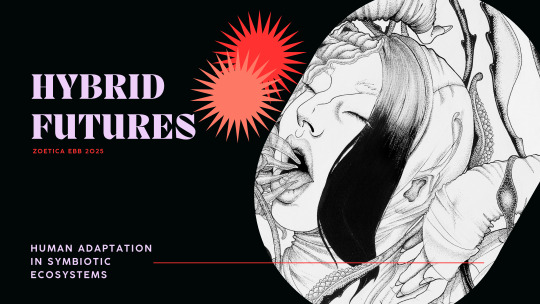
A transcript of the presentation about the paper, Hybrid Futures: Human Adaptation in Symbiotic Ecosystems, delivered on Friday, April 11, 2025 at The Adventures of Matter: Beyond the Boundaries of the Living and the Nonliving as part of International Vectors Conference.
[email protected] zoeticaebb.com
Hybrids

I’ve been studying bio-glitches, xenohybrids and psychogametous life-forms for the last decade at The Institute For Psychogametous Life. The main findings are presented in Chimeric Herbarium, published in 2022. It’s an archive of art and documentation from the lost Novy Mir mission. I’ll give you a brief introduction today.
Here you can see a few examples of the xenohybrids that I’ve been studying:
An aquatic predatory symbiote
A flowering organism with a 2-stage lifecycle
An aquatic metamorphic parasite
And a cave-dwelling temporary symbiote
Xenohybridisation
Xenohybridisation is our future as a species. Some might even say the process is well underway. How do we know if we are looking at a xenohybrid? To determine this, we need to understand least-interaction boundaries.
Least interaction boundaries
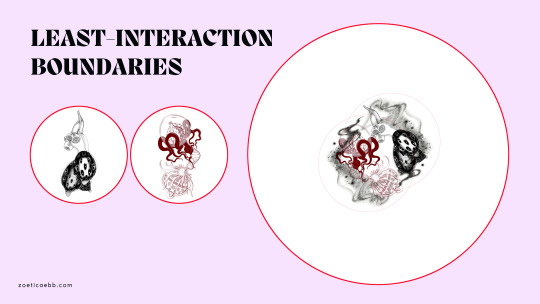
To analyse any system we must define what’s inside and outside. The boundary should be the smallest bubble that still contains all the essential parts and their interactions. This means the exchange through the boundary is minimized.
An ecosystem, whether it's a tiny mossy rock or the entire universe, is defined by this boundary of minimal exchange.
Now, imagine two organisms, each a self-contained world defined by its own least-interaction boundary. As they merge, more and more information, matter, and energy flow through the boundary between them.
Least-interaction boundary

Least-interaction boundary: the perimeter around a system where the flux of energy, information, and matter is minimised, i.e. its most contained state
When intertwined to the point of such codependency that separation means death, we can only think of them as a single organism, and the unified least-interaction boundary contains them both. This dissolution of boundaries is at the core of the hybridisation process.
Genetic Engineering

Some of you may be familiar with this famous early xenohybrid: Alba. She was a genetically-modified glowing rabbit created by artist Eduardo Kac and geneticist Louis-Marie Houdebine. Alba caused quite a scandal among the public and was seen as some kind of abomination. It probably didn’t help that Kac described Alba as an animal that did not exist in nature.
So what is a xenohybrid?
Xenohybrid (definition)
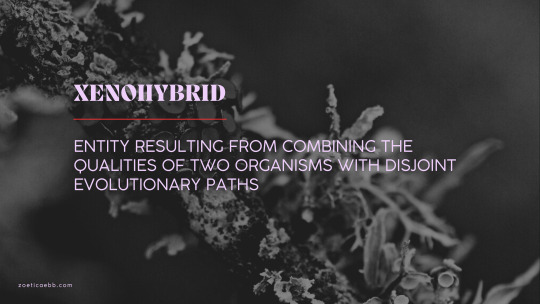
Xenohybrid: an entity resulting from combining the qualities of two organisms with disjoint evolutionary paths
All the organisms I’m studying intertwine with another entity for a substantial part of their lifecycle tо surpass their innate limits. When the two parts are genetically incompatible, we call them “xenohybrids”.
Desiderium papilionem

Our current research revolves around the study of an ecosystem on Chimera, the 11th moon of the gas giant Eesa-7 in NQ3. This ecosystem has distinct wet and dry seasons, and numerous lakes in perpetual tectonic flux. A few of these lakes are deep and stable, while most are small and only fill with water during the moon’s five rainy seasons. The ecosystems of individual lakes are simply not big enough to support large aquatic predators, making it necessary for them to move from lake to lake to get enough nutrients.
Take the Desiderium papilionem: a large aquatic predator that evolved well before the small lakes formed, during the time when a large central lake dominated the landscape. It had to adapt. To access the diverse nutrition from multiple lakes, it hybridizes with a native dry-land organism. This symbiont seeks out the Desiderium in a mutual instinctual process which appears to have co-evolved.
The Desiderium uses a retrovirus vector to introduce a DNA-modification sequence. This alters the partner for better aquatic performance by adding hydrodynamic features.
The adaptation allows the composite organism to hunt deep-water species and to thrive across a wide selection of lakes. This composite organism is the apex predator of the lakeland ecosystem.
Desiderium papilionem xenohybrid
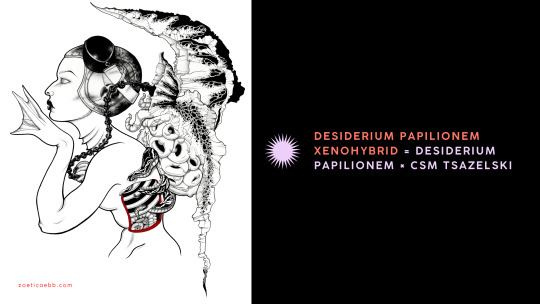
This is a fascinating and efficient process, particularly when we consider its versatility. We’ve learned that it’s not exclusive to the co-evolved local quadruped.
One example is the ordeal of Julie Tsaselski, Chief Science Monitor from the Novy Mir expedition. After total equipment failure, there was no going home. To survive in this harsh alien environment, and perhaps to sate her scientific fascination, Tsaselski personally underwent the Desiderium symbiosis. Sacrificing some of her humanity, she took the place of the local land organism, gaining aquatic breathing and jet-propulsion.
Desiderium papilionem +Desiderium papilionem xenohybrid

Usually, the Desiderium papilionem procreates by exposing its gametes to the water-borne pollen of other Desideria. Fertilised gametes develop into seeds and shed when the wet season ends, completing the cycle.
CSM Tsaselski’s new gills aid this process, undulating to draw the genetic material into her repurposed lungs to maximize pollen capture.
The mission log reads:
“In the downpour, Tsaselski’s new gills unfurled and throbbed subtly. Their sticky filaments ensnared drifting pollen, inviting it into the moist interior of her transformed lungs. Her breath, a deliberate invitation as it drew the pollen towards her, guiding the precious genetic dust into the receptive spaces inside.”
Although Tsaselski's transition was a drastic, and perhaps partially forced adaptation, the resulting composite organism presents a perfect example of the surprising possibilities of xenohybridisation.
Sometimes, profound restructuring is imperative.
Mutual Assimilation
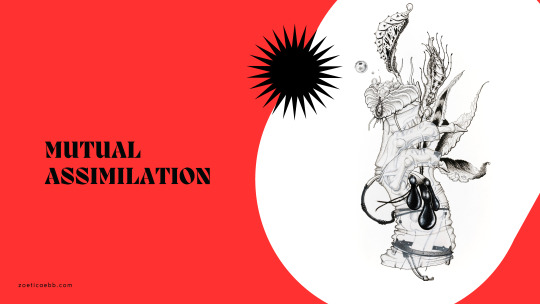
Let’s look at another one of our case studies: the entwined organism resulting from lab assistant Kira Sirotkina and a Lenticus somnium.
The Lenticus keeps its prey alive while detached gastropods digest the prey’s soft tissue. Then, the Lenticus uses the prey as an incubator.
Sirotkina engineered a retrovirus to make her DNA hack the Lenticus, but the experiment did not go according to plan. Her soft tissue hybridized with the Lenticus, replacing her muscles and ligaments with functional alien-botanical equivalents.
The log reads:
“The lake. It replays in my mind, that revolting tableau. Entry was textbook, the embedding, a brutal surprise. But it’s the feeding that haunts. The gastropods erupting from her skin. The initial screams, then this peace. Sighs mingled with wet tearing. Kira’s face – a flicker of something akin to contentment, even as those things dissolved her arm. Pleasure blooming in the abyss of pain. Muscles spasming, tissue being consumed, yet a soft exhale. Her prognosis was always grim, but this euphoric decay? None of us were prepared. All we can do is observe, but the lake… It’s stained with something beyond blood now.”
Records indicate that the resulting hybrid took residence in the shallow part of a nearby lake. It was observed coming back to Sirotkina’s duties on multiple occasions.
Note that in the schema from the archive, there is no sensible boundary to draw between the two organisms that formed the new entity, showing the hybridization process is complete.
It's human nature to become less human
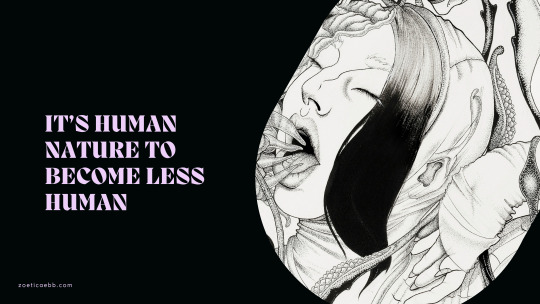
As Sirotkina and Tsaselski cases demonstrate, it's human nature to become less human. We seek out change for the sake of change, and hybridisation, once possible, becomes inevitable.
It’s a necessary adaptation to a rapidly changing world, reflecting the fundamental principle that ecosystems thrive through interaction and recombination.
Mergence with other life forms demonstrates a deep integration that fundamentally alters what it means to be human - yet nothing is more human than to seek it.
Bio-glitch
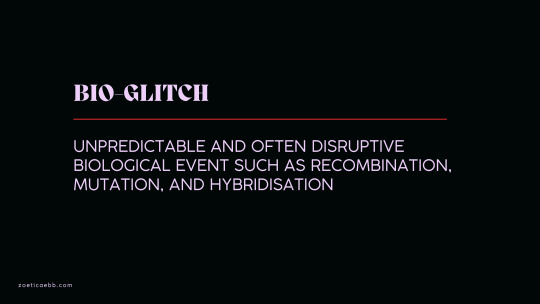
Bio-glitch: unpredictable and often disruptive biological event such as recombination, mutation, and hybridisation
Alien matter becomes integral and inseparable within the biological makeup of these new life forms, urging us to confront human identity in a world where the boundaries of "human" are increasingly porous.
Technological and medical advancements, bio-glitches, and the potential for multi-organism merging, beckon a new era of directed evolution, where hybridisation transcends our “natural” limitations.
Behavioural hybrid
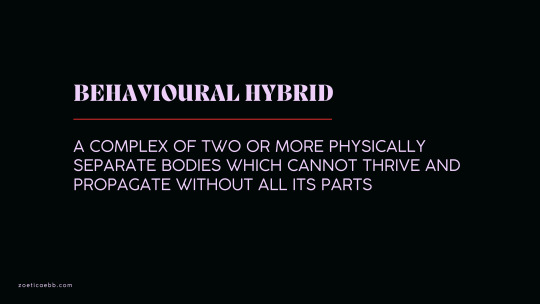
Behavioural hybrid: A complex of two or more physically separate bodies which cannot thrive and propagate without all its parts.
Aberrant Plexus

Here at The Institute For Psychogametous Life we have an entity that survived by using something that was already here - humans.
The Aberrant Plexus is an alien mycelium and a colony-organizer-manipulator. It’s theorised to have arrived with the capsule carrying the Chimeric herbarium archive.
Without its expected symbiotic partners, this xenomycelium has done something unexpected: it's keyed in on the fact that we're a social species. Our ingrained tendencies to connect, communicate, and cooperate? The Plexus seems to be leveraging that.
It exhibits a sensitivity to and influence upon the social dynamics of human subjects within its containment perimeter. Its exploitation of pre-existing social structures suggests a sophisticated strategy for environmental adaptation.
Humans start to operate in unison
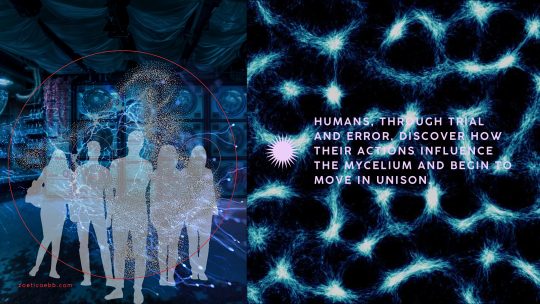
It’s clear that social interaction with the Aberrant Plexus drives its whole life cycle. How it grows, fruits, spores, and even seems to evolve.
And the researchers here are figuring out how to make it respond just by trying things out. It's a feedback loop: what we do changes the Plexus, and then how the Plexus reacts changes how we interact with it - and with each other.
We've seen the Plexus influence personnel to form incredibly tight-knit, almost collective groups. Over time, these individuals start acting more and more in sync, to where they seem less like separate people and more like parts of a single organism.
The least-interaction boundaries between the humans are obviously diminishing. The pronounced cooperation necessitated by the Plexus’ "interventions" is fostering an unusual degree of interdependence and synchronized action amongst the research team.
This looks like a real case of behavioral xenohybridisation, where the mycelium is making deep social connections happen without any physical merging.
Early data suggest that the Aberrant Plexus might be aiming for something bigger: a radical way to integrate our social structures into its own operating system.
If this behavioral manipulation precedes a deeper, non-invasive hybridisation, we must figure out what it's ultimately trying to achieve.
Humans are Hybrids
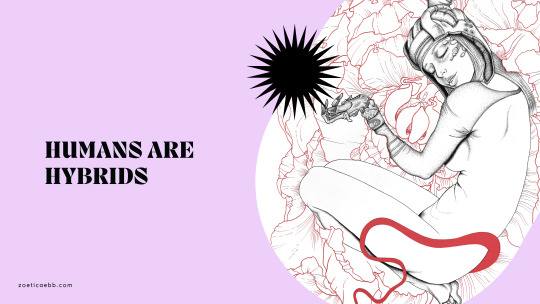
Our cells house the remnants of ancient viral infections and the DNA of once-free bacteria, the mitochondria – a primal form of biological merging.
Most of us carry Neanderthal DNA, an echo of interbreeding with another human lineage.
This inherent capacity for internalizing the "other" – a biological imperative for adaptation – now extends beyond our history. As our interconnected world accelerates, the lines fade.
Just as early life bio-glitched its way to complexity through symbiosis, we too are driven towards hybrid futures, a consequence of our inherent adaptability and the planet's interconnected signal-processing network.
Gaia Hypothesis
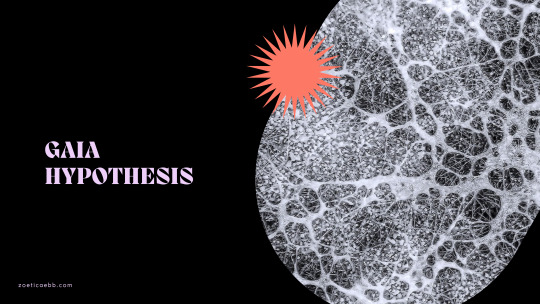
The Gaia hypothesis posits the entire planet as a self-regulating interconnected system, a vast network where all living and nonliving components are interdependent. Through the lens of xenohybridisation, this planetary ecosystem could be argued to fit the definition of a global-scale hybrid.
Hybrids with open reproduction cycles
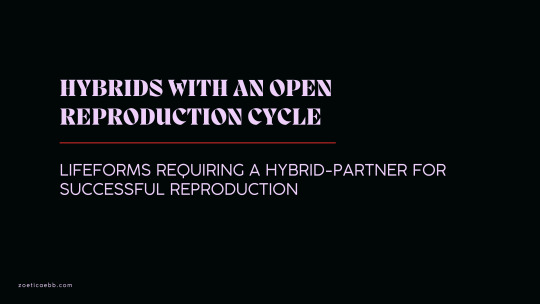
To understand the scope necessary to study our further evolution, we must also look at lifeforms with open reproduction cycles.
A life-form has an open reproduction cycle if it requires another life-form or hybrid-partner to reproduce successfully.
Lifeforms with open reproduction cycles
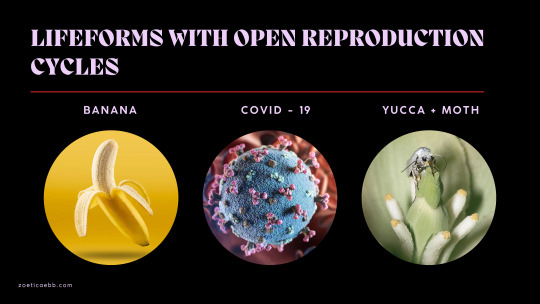
Cavendish bananas are extinct without humans - they’re seedless and humans clone them.
We are used by viruses that are inert on their own, but their RNA reprograms our cells to replicate them.
And in obligatory mutualism, the yucca moth and the yucca plant are reproductively codependent: the moth pollinates the flower and lays eggs inside, where the larvae are fed and protected by the plant.
Psychogametous lifeforms
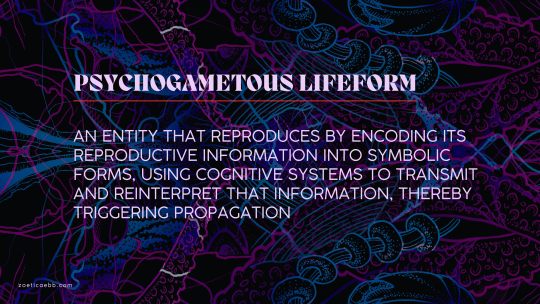
Psychogametous lifeforms also have open reproduction cycles. They replicate and evolve by leveraging other entities to transmit and reinterpret symbolic information.
First articulated in the Chimeric Herbarium, the term describes extraterrestrial organisms exhibiting this model, suggesting biological systems can utilize cognitive and cultural pathways for reproduction.
Unlike memes or word viruses, these lifeforms physically manifest after informational transmission, encoding their reproductive information into symbols for human cognitive propagation and adaptation.
Desire drives reproduction
Study: dissemination of psychogametous life forms
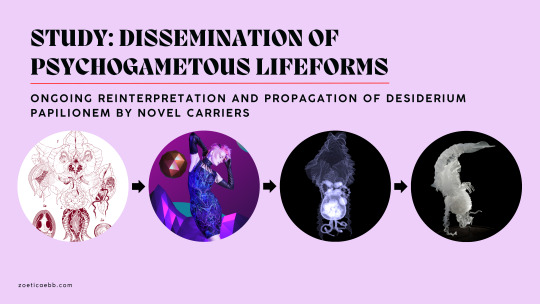
The Desiderium papilionem shows an impressive ability to adapt. A successful xenohybrid in its native environment, it’s also prolifically psychogametous. Its first non-biological manifestation was a drawing, reproduced by the hundreds in the Chimeric Herbarium. The manuscript then replicated in readers’ minds, coaxing them to find collaborators to propagate some of the drawings as graphic designs, and later, clothing.
As an exosymbiote, the clothing physically transformed their temporary hybrid partners, altered their self-perception, and raised their confidence. Consequently, the Desiderium spread further by fueling desire, and thus reproduction through made-to-order objects.
This spread eventually resulted in its next form: the digital model. The model then became a physical, infinitely reproducible sculpture made by the artist Peachthief who grew a digital Desiderium from cyber-seed, and used a 3D printer to make a physical specimen.
Each cycle occurred through a distinct human or group, and evolved into a different form, better adapted to its new habitat every time.
This evolution continues.
Hybridisation: an inevitable consequence of human nature
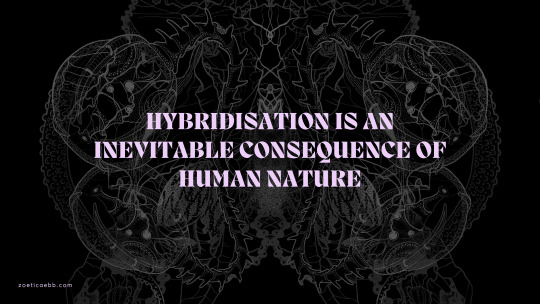
Humans are especially susceptible hybrid partners for life-forms with open reproductive cycles. In this, we find convergence with posthumanism, where the human is “permeable to other natures, other matters, and other cultural agents,”. Being human already involves surpassing the boundaries of human “nature”.
As we navigate a future where the very definition of "human" is in flux, I propose the ability to adapt to rapid and extreme levels of change as a defining aspect of humanity.
Matter with Agency
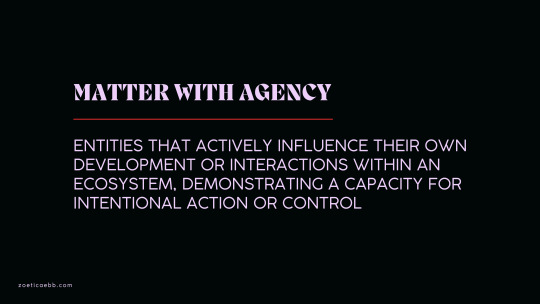
Our current definition of 'life' is inadequate. It doesn't account for entities like viruses, which exhibit a clear drive for self-perpetuation. The nature of psychogametous life-forms, AI, and 'uploaded' cyborgs challenges traditional biological definitions. “Matter with Agency” is a more encompassing term for entities with inherent directives.
These are matter possessed of agenda, driven by an intrinsic will to perpetuate. This raw self-directed imperative is the core of a useful definition of life. Beyond metabolism and reproduction, life is the hunger, the relentless push to be and become more. And in that primal drive lies a power that eclipses old notions of biology, a power that whispers of futures where the boundaries of flesh and code, organic and artificial, living and something more, dissolve into a new reality.
In striving to transcend humanity, we only redefine it
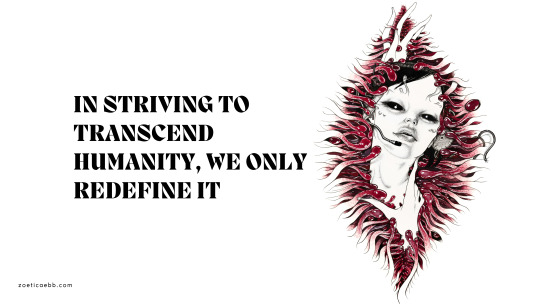
We reshape ourselves and our environment. Our drive to adapt and connect, already evident in our biology, is now amplified by technology.
Hybrids are an inevitable consequence of human nature.
We crave the beyond.
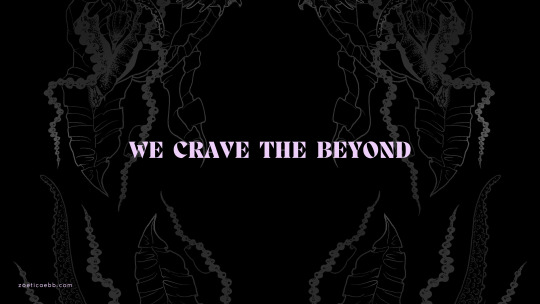
We're accelerating this process, seizing control of evolution. We're directly manipulating matter with agency into new biological forms and fusing technology with our minds and bodies. We're merging with bacteria, viruses, and sometimes even with each other. This reflects the essential human drive to transcend limitations and push beyond the boundaries of our nature.
We are matter with agency. It’s human nature to become less human.
Aemulor fictus

I’d like to touch on a type of hybrid we haven’t talked about yet: a hybrid mimic.
The Aemulor fictus is a parasitic predator whose reproductive strategy exemplifies a sophisticated form of parasitism. This flowering organism, with its striking morphology, actively seeks out and infiltrates the bodies of organisms from other species. Through a rapid cellular replacement process employing Pouyannian mimicry, the Aemulor fictus commandeers the host's form and sensory outputs.
Aemulor fictus hybrid mimic

The resulting short-lived hybrid mimic attracts pollinators through tactile, olfactory, chemical, and even audiovisual signals mimicking the host. It operates with limited functionality and ultimately decays.
This parasitic takeover achieves pollination, pseudocopulation, and genetic dispersal within hours, not generations. It’s a direct exploitation of the host's biological systems and even its cognitive functions for the sole benefit of the Aemulor fictus.
The mimic's eventual decay further underscores the parasitic nature of this interaction, utilizing even the host's decomposition to attract secondary pollinators.
Aemulor fictus and Aemulor fictus hybrid mimic

One final log entry for today from the Novy Mir mission, documenting the fate of Second Pilot Polina Kaihua:
“The crimson bloom erupted on Polina’s chest, its bearded flower twitching obscenely. Her eyes shimmered sugar-cataract pink. Viscous tendrils snaked out, anchoring themselves in flesh - a blooming corruption. A flicker in the gaze, a wrongness in the posture, a low murmur in the voice, broadcasting some kind of demented siren call. A puppet learning new strings as the flower pulsed, its stigma glistening with threat. Flesh rewritten cell by cell, to lure unseen pollinators to her: beautiful, terrible, and irrevocably lost.”
Adapt or Vanish

Although Kaihua’s fate is a cautionary tale, it doesn’t change our future.
Our fundamental drive to adapt and thrive in an ever-changing universe compels hybridization. "Life is artifact-making," and this extends to the molecular level, where organisms engage in codemaking processes that shape their evolutionary trajectory.
While the outcomes of such hybridisation may be unpredictable, they are inevitable. Embracing this fact, understanding the principles of ecosystem interaction, and acknowledging the semiotic agency of all components within the network will be crucial for navigating the new phase of human evolution.
Mergence with other life forms isn't a hypothetical scenario; it's an unfolding reality driven by our inherent desire to redefine what it means to be alive.
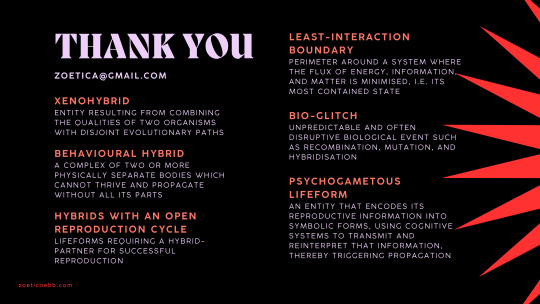
Thank You + Glossary
Least-interaction boundary: the perimeter around a system where the flux of energy, information, and matter is minimised, i.e. its most contained state
Bio-glitch: unpredictable and often disruptive biological event such as recombination, mutation, and hybridisation
Xenohybrid: an entity resulting from combining the qualities of two organisms with disjoint evolutionary paths
Behavioural hybrid: A complex of two or more physically separate bodies which cannot thrive and propagate without all its parts
Hybrids with an open reproduction cycle: lifeforms requiring a hybrid-partner for successful reproduction
Psychogametous lifeform: an entity that encodes its reproductive information into symbolic forms, using cognitive systems to transmit and reinterpret that information, thereby triggering propagation
#zoetica ebb#my work#alien botany#nature#xenobiology#hybrid#parasite#symbiosis#posthumanism#artist#artists on tumblr
129 notes
·
View notes
Text

hunting Jews: the truth about Hamas
SEPTEMBER 15, 2024
Islam is a religion.
Islamism is a political ideology.
Recently rescued Israeli hostage, Qaid Farhan Alkadi, an Israeli Bedouin Muslim, gave the following testimony:
Farhan’s testimony, along with a plethora of other evidence, only makes what we’ve been saying all along abundantly clear: Hamas is not a “resistance” group against oppression. Hamas is a genocidal antisemitic terrorist group that targets Jews.

ISLAMISM IS AN INHERENTLY ANTISEMITIC IDEOLOGY
Hamas is an Islamist terrorist group. What does this mean?
Islamists believe that the doctrines of Islam should be congruent with those of the state. Islamists work to implement nation-states governed under Islamic Law (Sharia), emphasize pan-Islamic unity (in most cases, hoping for an eventual worldwide Islamic Caliphate, or empire), support the creation of Islamic theocracies, and reject all non-Muslim influences. For this reason, Islamists tend to portray themselves as “anti-imperialist,” while in truth they are striving to swap western imperialism with Islamic imperialism.
Islamist ideology can be traced back to Hassan al-Banna and the Muslim Brotherhood, founded in 1928. Al-Banna viewed the 1924 dissolution of the last Islamic Caliphate, the Ottoman Empire, and the European colonization of the Middle East, beginning with France’s 1830 occupation of Algeria, as an affront to Islam. The early 20th century was a period of rapid secularization in the Middle East, when Arab nationalism threatened to replace pan-Islamic identity with a pan-Arab identity. Al-Banna opposed all of this, hoping to return to “authentic” Islamic practice through the (re)establishment of the Islamic Caliphate.
Islamism is an antisemitic ideology. Islamists hate Jews -- and by extension, the Jewish state -- because of the Prophet Muhammad’s conflict with the Jewish tribes of the Arabian Peninsula in the 7th century. Islamistsbelieve that the Israeli-Palestinian conflict is rooted in a struggle between Muslims and their “eternal enemies,” the Jews.
Hassan Al-Banna, the founder of the Muslim Brotherhood, viewed the dissolution of the last Islamic Caliphate (empire) and the secularization of the Muslim world as an affront to Islam.
ISLAMISM, DHIMMITUDE, AND THE JEWS
Islamists seek to revive “authentic Islamic practice,” by which they mean, essentially, that they wish to go back in time. This desire to turn back the clock puts them in conflict with Jews for two reasons:
During his earliest conquests, the Prophet Muhammad and his army came into fierce conflict with a number of Jewish tribes that had settled in Arabia, some of which had refused to convert to Islam and even accused Muhammad and his followers of appropriating figures from the Torah. For Islamists, this initial conflict between Jews and the earliest Muslims is “proof” that Jews are “eternal enemies” of Islam.
Following Muhammad’s death in 632, the Arab Islamic empires conquered lands exponentially quickly. As a result of this rapid colonization, the Muslim authorities were faced with the “problem” of how to handle the conquered Indigenous peoples that resisted conversion to Islam. This “problem” was solved with a treaty known as the Pact of Umar. This so-called treaty allowed select religious and cultural minorities, known as dhimmis, or “People of the Book,” to practice their beliefs so long as they paid the “jizya” tax and abided by a set of restrictive, second-class citizenship laws.
Under Islamist regimes, such as the Islamic Republic of Iran, Jews are, to this day, still treated as dhimmis.
THE GENOCIDAL ANTISEMITISM OF THE MUSLIM BROTHERHOOD
Hamas emerged as the Palestinian branch of the Muslim Brotherhood. Hassan al-Banna, the founder of the Muslim Brotherhood, worshipped Adolf Hitler.
Like Hitler, al-Banna sought to exterminate all Jews…in his case, from the Middle East.
According to German documents from the period, in the 1940s, the Nazis trained some 700 members of the Muslim Brotherhood. Nazi Germany heavily funded the Brotherhood, which contributed to its massive growth. In 1938, the Brotherhood had some 800 members. By the end of World War II, it had grown to a million members.
In 1939, Germany “transferred to al-Banna some E£1000 per month, a substantial sum at the time. In comparison, the Muslim Brotherhood fundraising for the cause of Palestine yielded E£500 for that entire year.”
Naturally, Nazism deeply influenced the Muslim Brotherhood’s ideology.
The father of Palestinian nationalism, Haj Amin al-Husseini, was a prominent member of the Muslim Brotherhood. Yasser Arafat, the most influential Palestinian leader of all time, began his “career” fighting for the Muslim Brotherhood. Which brings us to Hamas. Hamas’s founder, Sheikh Ahmed Ismail Hassan Yassin, was a member of the Muslim Brotherhood and was responsible for establishing the Brotherhood’s Palestinian branch. In 1987, he founded Hamas.
The Muslim Brotherhood’s hatred for Jews goes far beyond its original Nazi affiliations. During the 1936-1939 Arab Revolt in Mandatory Palestine, during which Palestinian Arabs revolted against Jewish immigration and carried out a number of antisemitic massacres, the Muslim Brotherhood began disseminating antisemitic rhetoric, often targeting the Egyptian Jewish community.
Al-Nadhir, the Muslim Brotherhood’s magazine, published openly antisemitic articles, peddling conspiracy theories and demonizing the Egyptian Jewish community for its success in various industries. Notably, Al-Nadhir even called for the expulsion of Jews from Egypt, accusing Jews of “corrupting” Egypt and calling Jews a “societal cancer.” Al-Nadhir made boycott lists of Jewish businesses.
Unfortunately, the Muslim Brotherhood’s antisemitism is not a relic of the past. Mohammed Badie, the Muslim Brotherhood’s present day “Supreme Guide,” believes Jews “spread corruption on earth” and calls for “holy jihad” as an antidote.



THE ORIGINAL HAMAS CHARTER: EXPLICITLY GENOCIDAL
Hamas’s founding 1988 charter is explicitly antisemitic and genocidal. Below are some excerpts:
“Our struggle against the Jews is very great and very serious.” -- Introduction
“The Day of Judgement will not come about until Moslems fight the Jews (killing the Jews), when the Jew will hide behind stones and trees. The stones and trees will say O Moslems, O Abdulla, there is a Jew behind me, come and kill him. Only the Gharkad tree, (evidently a certain kind of tree) would not do that because it is one of the trees of the Jews." -- Article 7
“In face of the Jews' usurpation of Palestine, it is compulsory that the banner of Jihad be raised.” -- Aritcle 15
“With their money, they took control of the world media, news agencies, the press, publishing houses, broadcasting stations, and others. With their money they stirred revolutions in various parts of the world with the purpose of achieving their interests and reaping the fruit therein. They were behind the French Revolution, the Communist revolution and most of the revolutions we heard and hear about, here and there. With their money they formed secret societies, such as Freemasons, Rotary Clubs, the Lions and others in different parts of the world for the purpose of sabotaging societies and achieving Zionist interests. With their money they were able to control imperialistic countries and instigate them to colonize many countries in order to enable them to exploit their resources and spread corruption there.” -- Article 22
“Israel, Judaism and Jews challenge Islam and the Moslem people.” -- Article 28
BUT...HAMAS CHANGED THEIR CHARTER!
Some Hamas apologists will tell you that Hamas no longer intends to exterminate all Jews, because in 2017, they “replaced their [openly genocidal] charter.” Well, lucky for you, Hamas is here to set the record straight. See, after releasing their “new” charter, Hamas co-founder Mahmoud al-Zahar assured the media that the 2017 document did not replace their original 1988 charter.
The 2017 document was thus not a “new” charter from a “reformed” Hamas, but rather, a propaganda document aimed at redeeming Hamas’s image to the west.
Since 2017, Hamas has made openly genocidal calls toward Jews. For example:
In 2018, Hamas’s Al-Aqsa TV media channel predicted “the cleansing of Palestine of the filth of the Jews.”
In 2019, Hamas Political Bureau member Fathi Hammad said, “You seven million Palestinians abroad, enough warming up! There are Jews everywhere! We must attack every Jew on planet Earth –- we must slaughter and kill them, with Allah’s help.” In 2021, Hammad called, via Al-Aqsa TV, for the Palestinians in Jerusalem to “cut off the heads of the Jews.”
In May of 2021, the leader of Hamas, Yahya Sinwar, led a rally in which the crowd was encouraged to chant, "We will trample on the heads of the Jews in front of everyone..."
ISLAMIST INFLUENCE ON PALESTINIAN NATIONALISM
The earliest Arab nationalists in Palestine were not necessarily Islamists. Falastin, an influential anti-Zionist, Arab nationalist newspaper, was founded by two Palestinian Christians in 1911. Khalil Beidas, who was the first Arab to identify as Palestinian, in 1898, was a Christian. Nevertheless, the Palestinian nationalist movement soon fell under the influence of the Muslim Brotherhood.
Initially, Palestinian Arab nationalists advocated for a unified Arab state in Greater Syria. In 1920, Haj Amin al-Husseini began advocating for an independent Palestinian Arab state. To draw people to his cause, which was not yet well-known to the average population, he began emphasizing the importance of Palestine to Islam, and particularly the importance of Jerusalem and Al-Aqsa Mosque. Soon, he began disseminating the libel that the Jews intended to destroy Al-Aqsa Mosque. This libel has cost thousands of Jewish lives and is spread widely to this day.
Early on, the Muslim Brotherhood in Egypt adopted the Palestinian cause. After World War II, Haj Amin al-Husseini, who had spent the war working as a propagandist for the Nazis in Berlin, escaped to Egypt with the help of the Muslim Brotherhood.
The Muslim Brotherhood fought against the State of Israel in 1948, along with other Islamist militias, such as the Army of the Holy War. Among its fighters were Yasser Arafat. In the 1960s, Arafat came under the influence of the Soviet Union and shifted his image to that of a communist counterrevolutionary, as opposed to an Islamist, though his rhetoric in Arabic continued emphasizing the importance of jihad and Al-Aqsa Mosque to the Palestinian movement. Nevertheless, after Islamic Revolution in Iran, after which the Islamic Republic adopted the Palestinian movement, and with the establishment of Hamas and groups such as Palestinian Islamic Jihad, Palestinian nationalism has once again been undergone an Islamization.
rootsmetals
as always: this post is not an endorsement of any given Israeli policy or politician. You can be highly critical of Israel’s handling of the situation without obfuscating or whitewashing the origins and goals of this ideology. It always, always came down to antisemitism. I won’t engage with straw man arguments in the comments 😗
MAIN SOURCES on Instagram
149 notes
·
View notes
Text
Something that really bugs me about Goncharov is I feel like not enough people consider the reason why the movie was made. In the 1970s Italy had the largest communist party in Europe that wasn’t part of the Soviet Bloc, and there always was a very real possibility of Italy becoming a communist state. Scorsese is American-Italian and has Italian citizenship, he would’ve known this when making the movie.
Goncharov takes on a distinct Anti-communist and anti-collectivist tone for a reason, and it’s because Scorsese was aware of the immense amount of social and political turmoil that communism would bring to southern Italy. I mean, the film opens with Goncharov shooting the Soviet Ambassador on his way to Rome, which eventually leads to the Italian army imposing the crackdown on Naples and Goncharov’s death at the end of the film, but the reasoning behind the killing is very apparent: if Italy became a socialist nation, Goncharov and other members of Italy’s mafias would be ruined both economically and socially. Socialist tendencies like collectivism and the state monopoly on politics would crush Mafia culture and power, which is centered around corruption and the ability for individuals to circumvent the system via political leverage. Most Mafias are also very conservative politically, because conservatives and other right leaning groups give Mafia’s more leeway and control. Communism, which is the most left leaning political ideology there is, wouldn’t. This would utterly ruin Goncharov and his gang and they would rather die (and eventually do) than see it happen.
The climax of the film sees the Italian army and Naples police engage in a brief but brutal struggle overnight against the various Naples mafia groups for control over the city, where the Mafia hoist the flag of the independent kingdom of the two sicilies, which ruled from Naples before being annexed by the Kingdom of Italy. This is the Mafia re-asserting political control over Naples, because for most of the film the Gangs and families are fighting amongst one another while their political power is being stripped away. The Mafia (& by extension, Goncharov) do this because they are fighting to keep Communism out of their home. There’s a reason why there’s no villain in these final scenes, just endless waves of faceless & nameless Italian soldiers dressed in red shirts. They represent both collectivist communists that do not have any concept of the individual self, and the members of Giuseppe Garibaldi’s (who was a socialist himself) expedition of a thousand, which was a military invasion of the Two Sicilies that led to the dissolution of the Two Sicilies as an independent nation. The members of this expedition wore red shirts. Meanwhile, the various Mafia groups all wear mismatched uniforms, and we’ve spent the last 2 hours of the film getting to know them, and each of them has their own death scenes, representing their fall to the ideology the movie portrays as fundamentally incompatible with who we’ve seen these people to be.
I see a lot of people complaining about the fact that Goncharov takes on these individualist, anti-communist tones and isn’t the uwu sad gay boy soft story they want, but for crying out loud the tagline of the film is “Winter comes to Naples” (in reference to the Soviet Union, which is in cold climate) and the most famous poster shows the Kremlin, and the film is from 1973 and was written by an American, of course the film is going to be anti-communist. I just wish people would stop and try and understand the thing that the film literally shoves in your face, which is that communism is incompatible with the ways in which some people live their lives and they would rather die than be socialist. Also the North-South divide in Italy is fucked and it prevents a lot of things from happening in the country.
76 notes
·
View notes
Text
Updates on Lewis Nixon's personal information.
Irene Nixon died Feb 2, 1969 in Princeton, NJ. (Source: New Jersey Death Index and Death Index Code)
Lewis Nixon and Grace Umezawa got married in Nevada March 19, 1969. (Source Clark County, Nevada)
Lewis Nixon sold his house in Princeton, with Irene Nixon Estate on deed, May 8, 1969. (Scource: Mercer Co. New Jersey)
(And please do not repost to reddit or other sites, if I wanted the research there I'd put it there myself. This is preliminary research and in a few weeks I will have more to add.)
I honestly have not looked into this until this Stanhope and friends fiasco, but needed an idea when Nix got involved date wise. I've read the Hester Blue Boar update post a handful of times without it making an impact that Irene died in the 60's until the last time I read it. And I remembered I pulled that Princeton house deed info when looking for Nixon houses and noted the 'Estate' beside Irene's name, but tossed it in a folder for later.
Speculation ahead-----
After a year of stalking/researching this man and his family, I got a feel for him. Lewis Nixon III makes things happen. He doesn't have time for a wedding when he wants to get married. He's gone to the courthouse in NYC twice. Gotten divorced in Vegas once. New Jersey and California are not fast enough for him. So I looked in NYC first, then Las Vegas records and found him.
Next, Irene. Clearly from the customs paperwork we have Grace and Lew have been together for a while. He would not wait if he was divorced, he would have married her already. So, Irene. Considering the fast marriage, I felt pretty good he waited until Irene passed to get remarried and started manually going through the NJ Death Indexes in starting with the year he got remarried, and there she was.
Reference again his divorce from Kathy as he scratched out 'incompatible' and wrote in 'drunkeness' which goes in her favor since she is divorcing him. That legally covers Michael a little more as it puts Lew at fault for the marriage dissolution. (Even if Kathy's next husband was waiting over the state line) Which could have helped when he was suing Stanhope's estate for Michael's share.
My point?
Lewis Nixon is loyal, do not confuse that with faithful. He is loyal to those who have been good to him (Dick and Hester) and Irene was good to him. She was there for him during the war, through the death of his parents, was there when his sister killed herself. There when Dick left for Korea and more permanently- Pennsylvania. I feel he waited because he didn't want to hurt her, or her family who he has been apart of since WW2 and taken her away from; I feel she was probably sick and they knew it. He waits until she dies and then married Grace? I feel this one month window is a statement that he didn't divorce her. (again, please give me some time for the docs to work through this theory. But there is no waiting period on marriage in Nevada -even back then.) Once again, a demonstration of loyalty in my eyes.
We the have the case of Lew and Grace and her name as "Nixon" on the customs card in 1962. I don't know how to explain it. I do know that passengers wrote their own address on there as I recognize Lew's chaotic handwriting anywhere. Did they fill out their own forms? I imagine the customs folks wrote it off passports but I can't answer this. If I cycle through the entire planeload the handwriting changes. Could this have been a cover for going to the same address? It's 1962, people were being arrested for cohabitating twenty years earlier, I have no idea what the environment was at the time. The free and hippie sixties were the later half of the decade, early 60s are the back end of the McCarthy era and Jello Abominations. Could it be two people in love testing the waters, maybe filling out each other's cards? (examples below for handwriting comparison.) Feels like it. But the official records point to them being married in 1969 and that's all I got.
I realize this means Dick Winters was wrong about the date, and believe me, he's haunting my phone over saying that. I am trying to track sources for the 1956 marriage and most seem to be Dick's book. Even My Heritage had the date, but looking into it the information came from AI scraping of wikipedia. Wikipedia in turn -Winters & Kingseed. However I do feel he was right about Nix being in love with Grace and never having known that feeling before. Marriage was a civil union until her, then he married the love of his life. She was also close to 50 at the time and sure as hell didn't need a man as she was one hell of a lady, so she was in love with him and the fact he was married didn't matter.
Documents under the cut





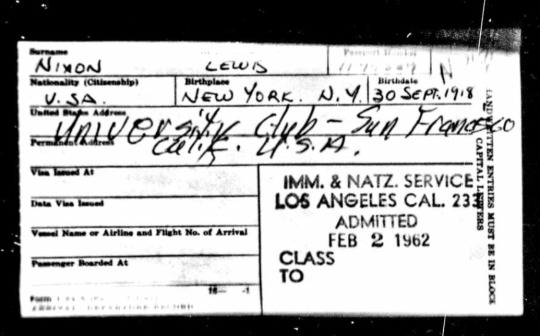


64 notes
·
View notes
Text
Queer/LGBTQ History in the Soviet Union
Since I started working on my novel, I’ve done a lot of research on LGBTQ history in the Soviet Union, which became a special interest for me. Since I always love to spread my special interests, here’s a bibliography of useful sources about queer history in the USSR. I believe this to be reasonably complete (I scoured JSTOR for articles and books) but I’d love to hear if I forgot anything. I’m also down to answer questions or help people access these resources if you DM me.
Books
Homosexual Desire in Revolutionary Russia - Dan Healey (2001)
Focuses on 1917-1940s. If you only read one book off this list, make it this one. Despite some outdated terminology, this remains the most central and accessible text on this topic, and it’s a good choice to read first to get a basic grasp. It combines a good sense of the broader context with a lot of fascinating details.
Russian Homophobia: From Stalin to Sochi - Dan Healey (2017)
Effectively a sequel to the above book, a series of historical anecdotes which cover 1945-2017.
Regulating Homosexuality in Soviet Russia, 1956-91: A Different History - Rustam Alexander (2021)
This book examines Soviet queer history through the lens of official discourse, i.e., the police, Gulag officials, the secret police, and doctors. This is useful both for understanding people in these professions, and for understanding people who were subjected to official control.
Gay Lives and ‘Aversion Therapy’ In Brezhnev’s Russia, 1964-1982 - Rustam Alexander (2023)
Red Closet: The Hidden History of Gay Oppression in the USSR - Rustam Alexander (2023)
This book attempts to bridge popular history and academic history, and doesn’t quite succeed - it has a lot of interesting information in it, but if you can, read Alexander’s other work (including the articles below) first.
Lesbian Lives in Soviet and Post-Soviet Russia - Francesca Stella (2014)
Chapter Two, “Lesbian Relationships in Late Soviet Russia,” contains a lot of valuable information. I admit I found the writing style rather dry.
Out of the Blue: Russia's Hidden Gay Literature: An Anthology - Kevin Moss (1996)
This anthology of literature in translation mostly features pre-Revolutionary and post-Soviet fiction, but it’s the only source for English translations of several valuable Soviet artistic works and primary sources, including Mikhail Kuzmin’s diaries and works by Gennady Trifonov.
Soviet and Post-Soviet Sexualities - Edited by Richard C.M. Mole (2019)
Queer History of Belarus in the second half of the 20th century: a preliminary study - Uladzimir Valodzin (2016)
Forced underground: homosexuals in Soviet Latvia - Rita Ruduša (2014)
Moscow - Yevgeny Fiks
Not an academic research book, but photographs of "gay cruising sites in Soviet Moscow, from the early 1920s to the USSR's dissolution in the early 1990s."
Articles
The Queer Life of Lieutenant Petrenko: The KGB and Male Homosexuality in the Ukrainian SSR of the 1960s - Rustam Alexander (2023)
"With a Shade of Disgust": Affective Politics of Sexuality and Class in Memoirs of the Stalinist Gulag - Adi Kuntsman, Slavic Review, Vol. 68, No. 2 (Summer, 2009), pp. 308-328
“Not a Personal Matter”: Soviet Conservative Discourse on Homosexuality in the 1960s and 1970s - Irina Roldugina (2024)
An inconspicuous sexual dissident in the Georgian Soviet republic: Subjectification, social classes and the culture of suspicion in the late Soviet period - Arthur Clech (2021)
Gay in the Gulag - Yaroslav Mogutin (1995)
Using the Past to Save the Present: Soviet Transgender History and Its Implications for Present-Day Trans Rights in Russia - Yana Kirey-Sitnikova (2025)
Transsexual and intersex individuals in Soviet medicine and jurisprudence - Yana Kirey-Sitnikova (Date of release unclear - recent)
The Trans Man Whose Pioneering Surgery Was A State Secret For Decades - Daniil Turovsky, Buzzfeed News (2018)
Documenting the queer self: Kaspars Aleksandrs Irbe (1906-1996) in between unofficial sexual knowledge and medical-legal regulation in Soviet Latvia - Ineta Lipša (2021)
Taming the desire: Pavel Krotov’s “bisexual” closet - Rustam Alexander (2021)
The inner lives of queer comrades in early Soviet Russia - Artem Langenburg interviewing Irina Roldugina, openDemocracy.net (15 December 2017)
‘Why are we the people we are?’ Early Soviet homosexuals from the first-person perspective: New sources on the history of homosexual identities in Russia - Ira Roldugina in Soviet and Post-Soviet Sexualities (2019)
Criminal Prosecution of Homosexuals in the Soviet Union (1946-1991): Numbers and Discourses - Uladzimir Valodzin (2020)
"With a Shade of Disgust": Affective Politics of Sexuality and Class in Memoirs of the Stalinist Gulag - Adi Kuntsman (2009)
“Not a Personal Matter”: Soviet Conservative Discourse on Homosexuality in the 1960s and 1970s - Irina Roldugina (2023)
Political Homophobia in Soviet Lithuania Revisited: The Case of the Dissident Viktoras Petkus - Rasa Navickaitė (2024)
Translating queer texts in Soviet Russia: A case study in productive censorship - Brian James Baer (2010)
Usto Mumin: The Life and Work of a Great Artist as Seen in Recent Books - Eleonora Shafranskaya and Boris Chukhovich
An interview with two authors about their books, which cover the history of Usto Mumin, a queer artist in the early Soviet period. Their books do not appear to exist in English, so I present this interview in their stead.
Dissertations
The Queer Legacy of Ivan the Terrible - Maya Garcia (2023)
A book analyzing multiple depictions of Ivan the Terrible that depict queer characters; the first depiction analyzed is a pre-Revolutionary opera by Tchaikovsky, but the dissertation then moves on to discuss several Soviet works.
Fifty Shades of Vice: Decolonizing the Soviet Homophobic Legacy - Feruza Aripova (2023)
Contains some very useful research on queer history in Uzbekistan specifically
52 notes
·
View notes